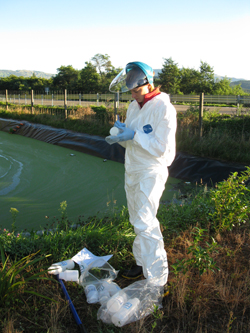Livestock effluent goes from being a major health and safety concern to an environmental success story in New Zealand.
by Simone McClenaughan
There is no delicate way of putting it … livestock effluent – that is, urine and faeces – is wreaking havoc on New Zealand roads. It has been for years.
“It’s a national problem that goes back to the 1970s, when livestock transport became more popular and there was increased access to grazing areas, particularly the habit of seasonal grazing,” explains Graham Eagles, Project Manager at Opus International Consultants, a multi-disciplinary infrastructure consultancy. As a result, the numbers of trucks increased, which meant more livestock and, in turn, more effluent spilt out of the trucks.

“In the 1990s, through pressure from the public and local authorities, the livestock and trucking industry started installing effluent tanks, which alleviated the problem somewhat, but created another issue – there was nowhere to safely dump the effluent,” says Eagles.
The National Stock Effluent Working Group (NSEWG) has been working to solve that problem ever since. The group is made up of parties with an interest in the problem – government, road authorities, farmers and truck drivers. Convenor of the group, Fiona Knight, says “everyone plays a part in solving the problem and minimising the effluent on the road.”
The main way the group is doing this is encouraging relevant councils and organisations to develop waste disposal sites. “This is often a challenge, as not many councils want the sites because of the maintenance costs, lack of funding, and the misconception that the sites smell,” says Knight.
Since NSEWG’s inception in 1997, more than 30 effluent waste disposal sites have been constructed and at least another 30 are in the pipeline. The site at Glengarry, along the State Highway 5 in New Zealand’s North Island, is just one of the recently developed disposal locations.
It’s all about location
The New Zealand Transport Agency (NZTA) wanted to establish a facility in the Napier region on the east coast of the North Island. Opus was commissioned to make it happen, but it was no easy feat.
“The challenges were fairly extreme,” recalls Eagles. “We looked at a number of locations and disposal options, but most of them would have proved too difficult to implement. The option that stood out was the Glengarry site.”
Glengarry was a known area for effluent dumping, with evidence of it littering the highway’s shoulders, drains and vegetation. Glengarry was also on Crown Land, which also made it an easier option to construct on.
However, while these two elements were strong positives in developing at Glengarry, the site was not without its challenges. “It was on a ridge with access sandwiched between north- and south-bound passing lanes, and we needed to fit the disposal system into the terrain. But even with those challenges, it was the best option and we simply had to make it work,” says Eagles.
The team did one better and constructed a double facility, with a disposal site on either side of the highway, thus accommodating livestock trucks travelling north and south. It is the only double facility in New Zealand.
Making it work
Eagles and his team visited a number of other effluent disposal systems throughout the country, collated their research, corresponded with Knight and devised a plan that would work for the Glengarry site.
“We decided that a pond system would be best,” says Eagles. Pond systems are a well-established method of treating effluent, mimicking the decomposition process in nature. “We wanted to imitate what happens in nature and replicate it on a larger scale. This ensures that the effluent is treated in the most natural way possible and decreases the carbon footprint.”
The system has multiple stages. First, the trucks park over a grated area and release the waste from the tanks. This deposits the waste into a large anaerobic pond that works like a giant septic tank, in which the effluent is broken down in an oxygen-free environment by bacteria. This then feeds into a smaller aerobic pond where algae growth further breaks down the effluent, which is then piped into surrounding, purpose-planted wetlands. “The system relies on bacteria and nature to do the work for us. We simply gave it the right environment and let mother nature take her course.”
It is certainly working, and has the environment’s stamp of approval – as seen in the influx of wildlife in the area. Soon after it was built, the anaerobic pond attracted frogs and the wetlands are now home to a large range of aquatic insects.
The Glengarry site has been operational for four years now, and its success is clear. Effluent has been eliminated from the highway, the environment has been improved, as have the road conditions, which are no longer at risk of deteriorating from the effluent. Safety is also greatly improved for motorists.
“The way the ponds and the site work is better than we expected, especially considering the difficulty of the location,” says Eagles. “This is testament to the design process and parties involved. I am most proud of this site because it is working so well. Touch wood it will continue to do so.”
This article originally appeared in Public Works Professional,
May-June 2014.